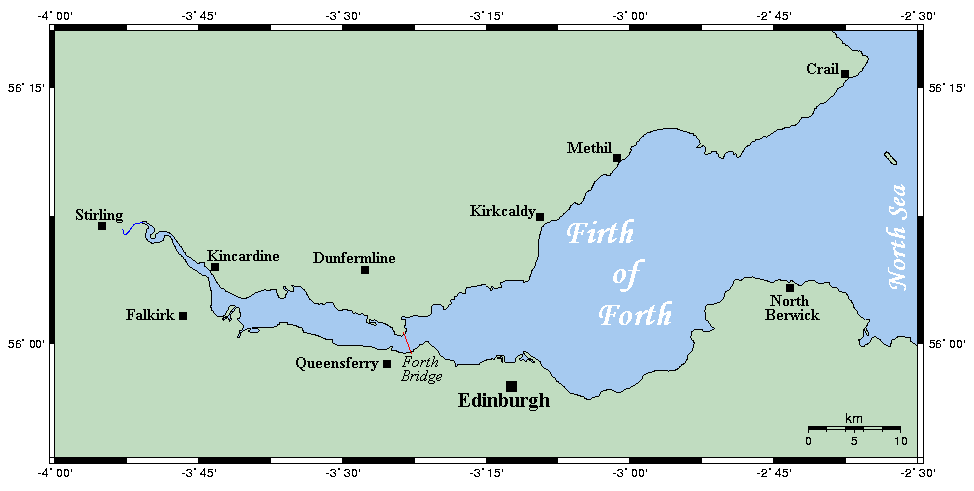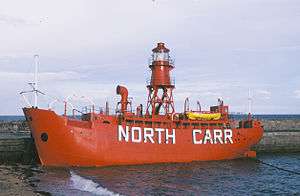North Carr
The North Carr Reef (also known as North Carr Shoals, Carr Briggs & North Carr Rocks) is a sandstone reef northeast of Edinburgh, on the headland between the Firth of Forth and St Andrews Bay. There have been many ships wrecked on the reef, which lies on the busy shipping lanes into the Forth ports and the River Tay.

A buoy was first placed on the reef in 1809. After much difficulty a more permanent, unlit, beacon was completed by Robert Stevenson in 1821.[1] Between 1877 and 1975 the beacon was supplemented by a series of lightships. The beacon still stands to this day, but the reef is now guarded by the Fife Ness lighthouse on the mainland.
Description
The reef extends for 1.5 miles (2.4 km) northeastwards from Fife Ness Points Coastguard station (East Coast Fife) into the North Sea and the greater Firth of Forth. It is made up of some fourteen sandstone rocks that are completely submerged at high tide. These include Englishman's Skelly, Kneestone, Tullybothy Craigs, Lochaber Rock and Mary's Skelly. The word carr in Gaelic can be translated to English to mean the flesh of a seal or a whale, possibly because the rocks look like the back of a whale or seals or the animals were hunted on the rocks.
History
Shipwrecks around the reef include the schooner Louise; the trawlers James Ross & Festing Grindall; the tanker Vildfugl; the brig Andreas; the paddle steamer Commodore; the coaster Island Magee; the cargo steamer Einar Jarl & Bjornhaug.
A buoy was first placed by the Northern Lighthouse Board in 1809, but this was found to be inadequate and would wreck in winter storms.[2] The remains can still be seen of a second project, the North Carr Beacon. This was started in 1813 by Robert Stevenson, a famous lighthouse engineer.[1] Stevenson had just finished the Bell Rock Lighthouse and was about to start a new lighthouse on the Isle of May, 8 miles to the south of North Carr.[2] Since North Carr was barely uncovered even at low tide, work could proceed on only two or three tides each fortnight, so the plan was to work on it when conditions allowed and switch the men to the Isle of May at other times.[2]
Stevenson planned a 40 feet (12 m) hollow tower topped by a bell.[2] The bell would be rung by an ingenious mechanism powered by the tide.[2] The foundations of North Carr were confined to just 18 feet (5.5 m) of fractured sandstone, a limited "toehold" compared even to Bell Rock (42 feet (13 m)) and whilst it was under construction parts of the structure were swept away in storms in 1815, 1816 and 1817.[2] In 1817 the tower had been nearly complete when it was reduced to the fifth course of stones, so the design was changed to a pyramidal structure of cast iron columns with a ball on top.[2] This was completed in 1821; £5,000 had been spent in total.[2]

A lightship on loan from Trinity House joined the beacon on 7 June 1887, located one mile off North Carr.[3] The 8 feet (240 cm) fixed light could be seen for 11 miles (18 km).[3] Two years later it was replaced by a ship purpose-built for the Northern Lighthouse Board by Alexander Stephen and Sons of Dundee.[3] This was sold in 1933 and replaced by a vessel built by A. & J. Inglis of Glasgow.[3] This had a 1000W electric light, fixed at first and later flashing twice every half minute.[3] It was moved to the mouth of the Clyde during World War II.[3] The lightship broke adrift from her moorings in a gale on 8 December 1959 and all eight crew members of the Broughty Ferry lifeboat died trying to rescue her.[4] The crew of the lightship managed to set anchor off Kingsbarns and were taken off by helicopter the next day but the ship was not taken under tow until 11 December.[3] The lightship was replaced by a lighted buoy in 1975, at the same time as a lighthouse was built at Fife Ness on the mainland.[3][1] The lightship was saved from the scrapyard in 2010 and funds are being sought by the Taymara charity to restore her as an exhibition space on the Dundee waterfront.[4]
Visiting
Visitors can park in the Crail Golfing Society carpark and follow the track that leads to the lighthouse and Coastguard Station. The rocks are only visible at low tide. It is worth taking binoculars; pods of dolphin and less frequently whales can be seen from the shore.
References
- "North Carr Rock: Overview". Gazetteer for Scotland. Retrieved 31 July 2018.
- "Stevenson v. North Carr Rocks". David Taylor, FSA.Scot. 2000–2011. Retrieved 15 September 2011.
- "North Carr Lightships". David Taylor, FSA.Scot. 2000–2011. Retrieved 15 September 2011.
- Urquhart, Frank (10 September 2010). "Just £1 saves the last lightship from scrapyard - but now £½m is needed". The Scotsman.
- Rosie, George (4 April 1998). The Scotsman Weekend. Missing or empty
|title=(help)